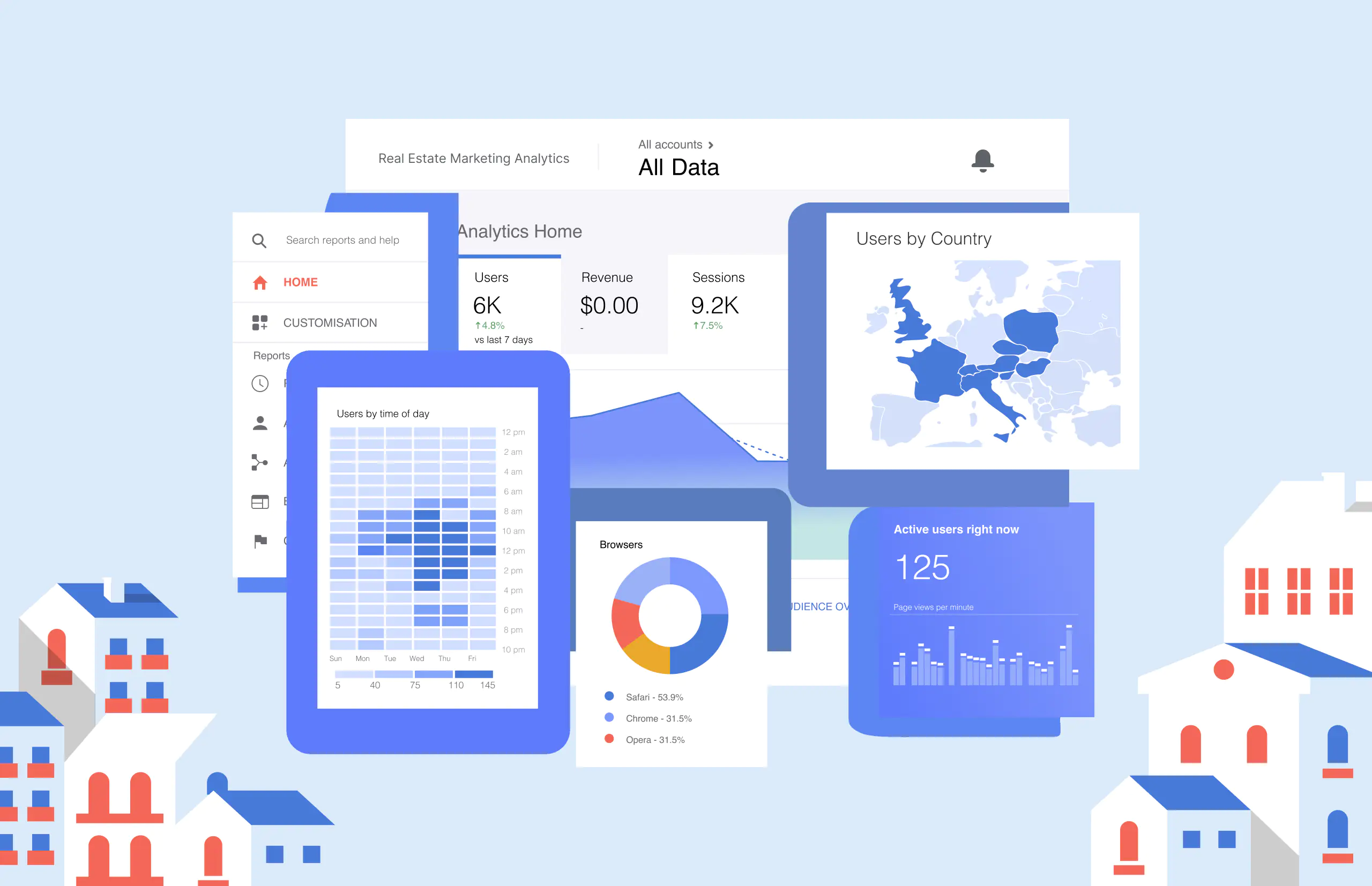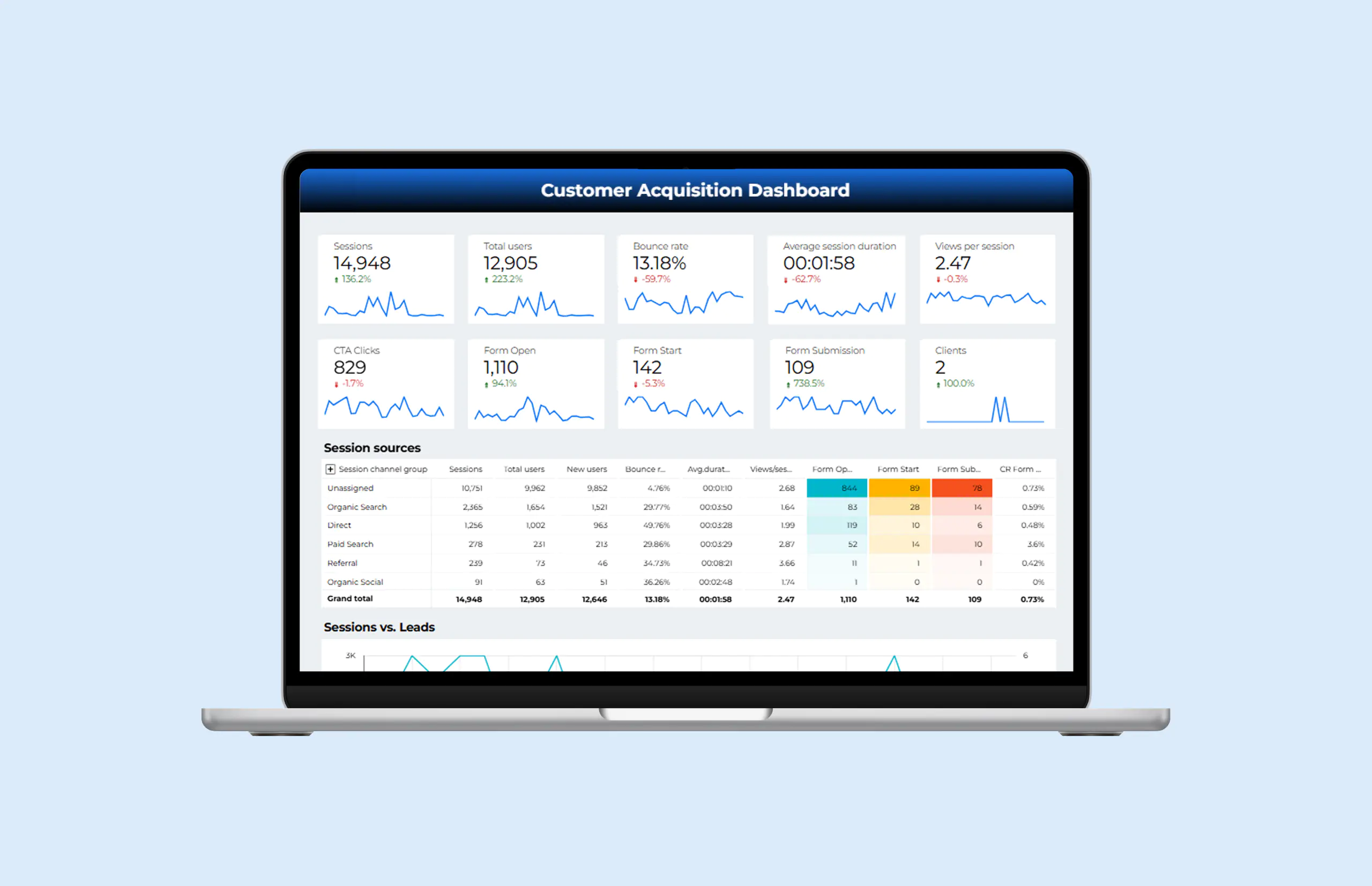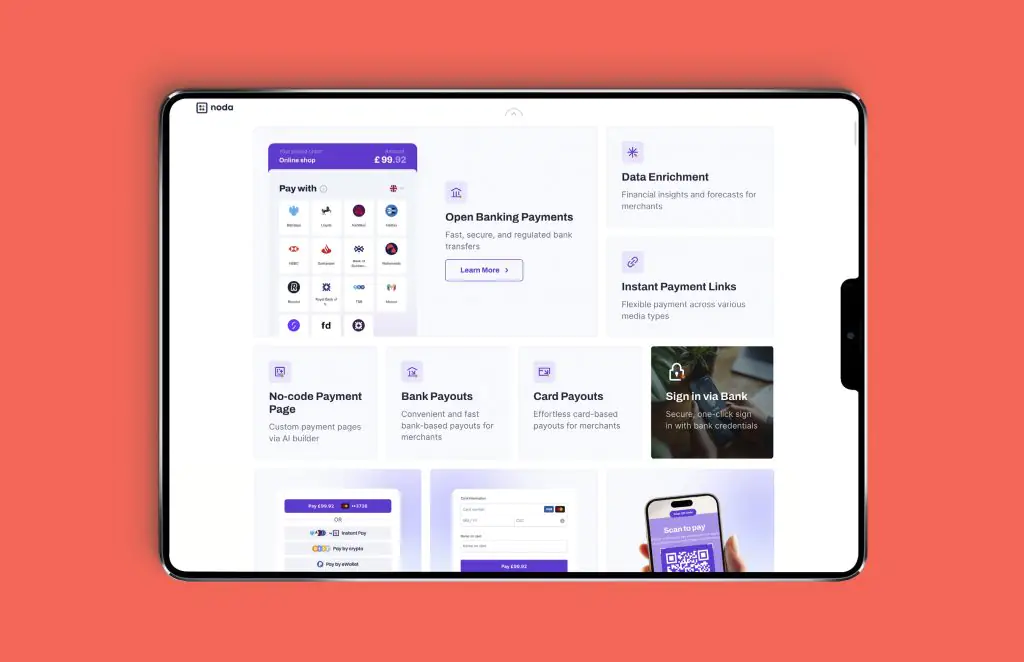
Why Developers Need Marketing Analytics
You can invest heavily in advertising and run dozens of campaigns across platforms like Google, Meta, and TikTok—only to end up with nothing but attractive statistics. Why? The answer is simple: without a structured analytics system, no one truly understands how marketing and lead generation actually work.
Analytics enables developers to:
- Identify Channels That Truly Drive Sales
From Google Ads to Meta, TikTok, LinkedIn, SEO, and aggregators—there are many advertising channels, but not all deliver quality. Analytics shows which sources bring valuable leads, not just traffic, allowing budget reallocation to more effective channels for maximum ROI. - Understand User Behavior on the Website
Only 5% of users typically submit forms on real estate sites. Why? It could be a long form, poor mobile experience, hidden buttons, or slow load times. Analytics identifies where and why users drop off. - Optimize the Entire Sales Funnel
See the full journey—from click to call, and from call to closing—and determine where improvements are needed. - Build End-to-End Analytics
Real estate deals have long cycles. Today’s marketing impacts tomorrow’s revenue. End-to-end analytics connects data from websites, ad platforms, call tracking, and CRMs for a complete performance picture.
In essence, analytics transforms a developer’s marketing from a “black box” into a measurable, manageable system—especially critical in a high-risk, high-investment environment.
Key Metrics That Matter
Online real estate marketing should focus on business-critical KPIs:
- Lead Volume—Total number of inquiries (calls, consultations, reservations);
- Lead Quality—Percentage of relevant, high-intent leads;
- Cost per Lead (CPL)—Cost of acquiring one inquiry via ads;
- Customer Acquisition Cost (CAC)—Full cost of converting a lead into a buyer;
- Website Conversion Rate—Leads divided by total site visitors;
- Micro-Conversions—Actions like viewing floor plans, downloading brochures, or using mortgage calculators;
- Sales Cycle Duration—Time from first contact to deal;
- ROI/ROAS—Return on investment in advertising.
These metrics help map the sales funnel, identify weak points, and optimize performance—from messaging to website usability.

Essential Tools for Analytics & Marketing
A single tool isn’t enough for effective analytics. You need a connected system that tracks the full customer journey:
Google Analytics 4 (GA4)
- Tracks user actions (clicks, form submissions, scrolls, etc.); integrates with Google Ads for campaign evaluation and remarketing.
- Requires accurate configuration of events and conversions.
CRM Systems (Hubspot, Salesforce, Pipedrive, etc.)
- Manage leads and customer data; track lead sources and post-inquiry behavior.
- Works best with call tracking and UTM parameters.
Call Tracking Services
- Vital for developers receiving a large volume of phone inquiries.
- Tracks calls, connects them to ad sources, and allows lead quality evaluation.
- Must sync with CRM and ideally integrate with GA4.
Ad Platforms (Google Ads, Meta, TikTok, LinkedIn, etc.)
- Provide traffic and initial engagement data; allow goal-setting, remarketing audiences, and conversion optimization.
- Ensure proper conversion tracking (e.g., offline import, server-side tracking).
BI Tools (Looker Studio, Power BI, Tableau, etc.)
- Visualize reports and dashboards; combine data from GA4, CRMs, and ad platforms.
- Used by marketing teams, CFOs, and executives for performance monitoring.
Support Technologies (GTM, BigQuery, Webhooks, etc.)
- Google Tag Manager (GTM): Manages tags and events centrally.
- BigQuery: Stores raw data (e.g., GA4 exports).
- Webhooks/API: For syncing data across systems.
Consent Management Platforms (CMP)
- Collect and manage user consent in line with privacy regulations (GDPR, etc.).
- Control whether cookies and tracking are allowed.
- Enable Consent Mode for GA4 and Google Ads.
Top 5 Obstacles to Effective Analytics
Online analytics in real estate faces both technical and structural challenges specific to the industry. By taking these into account from the very beginning, it is possible to build a system more accurately and efficiently.
01 | Long Sales Cycles
Because of this:
- It is difficult to determine the true source of the request;
- It is difficult to link advertising costs to the actual transaction (there is a “gap” between digital data and offline sales).
Solution: Track traffic sources in the CRM and import offline conversions into advertising platforms.
Result: The budget is allocated to channels that generate real sales. Leads and clients from advertising become more cost-effective.
02 | Lack of Call and Offline Visit Data
Because of this:
- Phone channels go untracked;
- Showroom and office visits aren’t recorded.
Solution:
- Dynamic call tracking;
- Linking calls to traffic sources;
- Call quality assessment;
- Recording offline visits in the CRM and linking them to inquiries;
- Transferring data to GA4 and advertising accounts.
Result: An accurate assessment of advertising’s contribution to sales and its rapid optimization based on call quality.
03 | Multichannel Complexity & Blurred Attribution
Because of this:
- Last-click attribution distorts the picture — for example, advertising that played a key role may go unnoticed.
Solution: Use data-driven attribution (DDA) in GA4, which considers assisting channels and ensures proper use of UTM tags.
Result: The contribution of all traffic sources is accounted for, allowing for budget planning based on the entire sales funnel.и.
04 | Privacy, Cookie Issues & Data Loss
Because of this:
- The current privacy policy significantly limits data completeness.
Solution: Despite these limitations, data accuracy can be improved by using:
- Advanced Consent Mode (Google receives anonymized data and uses modeling to process it);
- First-party cookies and server-side tracking;
- Storing the initial traffic source in the CRM.
Result: More data and touchpoints are included in reports, enabling more accurate ad performance measurement.
05 | Weak CRM Integration
Because of this:
- It is impossible to track the path from the application to the deal;
- There is no data on which ad brought the client;
- The sales department does not record the deal status or mistakenly closes deals.
Solution:
- Integrate the website and analytics with the CRM;
- Transfer UTM tags, Google Click ID, Facebook Click ID (FBCLID), and other parameters.
- Configure processes within the CRM.
Result: A connection is established between the first touches and the final funnel stages — linking actions to results.
How to Build a High-Impact Analytics System: Best Practices
- Start with Goals, Not Tools
Define the decisions you want to make based on data, then choose tools to match the objectives—not the other way around. - Set Up Website Tracking
Use GTM and GA4 to track form submissions, phone clicks, scroll depth, and CTA engagements. - Store Lead Source Data in CRM
Capture UTM tags, gclid, fbclid, _fbc, _ga , etc., from the first visit for proper attribution and offline conversion matching. - Implement Call Tracking
Use dynamic number insertion and connect calls to ads and CRM. Evaluate call quality to assess lead value. - Enable End-to-End Analytics
Integrate data from ads, website, call tracking, and CRM into one system. Track the full journey: Click → Lead → Deal → Revenue. Use BI dashboards. - Visualize Key Metrics
Build dashboards for campaign performance, traffic, CPL, and sales team efficiency. - Invest in Team Knowledge
Train staff, discuss data regularly, and assign a dedicated analytics owner. - Start Small but Consistent
Even a basic setup (GA4 + CRM + call tracking) delivers value. Then scale up with BI, advanced attribution, and server-side tracking.
Several words in the end
Modern real estate marketing is all about data and analytics—not just creativity.
Analytics isn’t a technical add-on; it’s a strategic asset.
As competition increases, click prices rise, and decision cycles lengthen, relying on intuition is risky. Solid analytics reveals what works and what doesn’t, enabling smart budget allocation across creatives, channels, and platforms.
Transitioning from gut-feel marketing to a data-driven strategy gives developers a critical edge. At RocketScience, we build comprehensive analytics systems and help real estate companies make decisions based on data—not guesswork. That’s the true growth lever.



 Return
Return  Share
Share 







